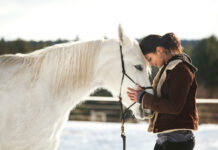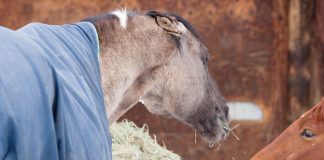
Safety First!
Your barn aisle must be wide enough for your horse to turn around without bumping into anything, so remove all hanging objects on the stalls that jut into the aisle.
Be mindful of herd dynamics. Don’t try an exercise right in front of the herd boss’s stall if she’s apt to lunge with bared teeth into your space.
Don’t try any training if all your horse’s body language says “not today.” Use common sense – don’t choose a day when he’s been inside for days and already hyper, carpenters are hammering on the roof, feeding time is minutes away, or a thunderstorm is approaching.
If your horse starts getting fidgety or uncooperative, don’t push him. Either try something easy for him until he calms or put him back in his stall. Aisle space is too tight for a fight. Relaxation on both your parts is the key to success.
Do these exercises in short sessions especially for youngsters. If your horse doesn’t understand an exercise, work with him briefly, then move on to something else and try again the next day.
Let your horse learn by watching; horses take their cues from others just like we do. Don’t rush the learning process and always reward a try by releasing pressure and using encouraging words.
Never use force or fear to try to teach a horse anything especially in a relatively confined space like a barn aisle.
Exercises
Move away from pressure
Put pressure on your horse’s side with the handle of a crop until he takes a step away from the pressure. Wait until he does it, then IMMEDIATELY release the pressure. Repeat on both sides.
Lower head
Again, get your horse to move away from pressure by pressing your fingers down on his poll just enough to be a nuisance (you’re not pushing his head down.) It may take a while, but stay with it until he lowers his head even a tad. Always reward the slightest try with release of pressure.
Yield to the bit
Standing slightly to the side in front of your horse that is bridled with a smooth, jointed snaffle, hook your thumbs through the bit rings and apply slight pressure backward. If he doesn’t yield and “nod” to the rear, keep the same pressure and “toggle” gently from one side to the other so your horse can’t brace against you. Increase pressure until you get a response.
Pick up feet
If your horse has issues about picking up his feet, loop a soft rope around his fetlock and lift the leg up and hold it until he settles. Stand safely out of kicking range and be patient until he accepts it.
Walk across tarp, blanket, or plywood
Throw an old saddle blanket on the aisle floor and have your horse walk over it. If he hesitates, let him sniff it before urging him forward. He may try to sidestep or hop it, but eventually that will be too much effort and he’ll cross comfortably. Put a ¾” square of plywood on the floor and have him cross that. It’s great training for stepping onto bridges or hollow-sounding trailer floors.
Back up
Say “Back” and gently pull back on your horse’s halter while pressing the handle of a crop in the middle of his chest until he steps back.
First Saddling
Introduce your youngster to saddling by showing him a saddle pad, letting him sniff it, rubbing him with it, and eventually placing it on and off his back from both sides. Assess his reaction to each step before going to the next. When he’s totally bored with the pad exercise, introduce the saddle the same way. You can hand-pull a cinch up until it touches him and then let it go a number of times, but never secure a cinch for the first time in an aisle.
Clipper training
Trim the whiskers of a horse accustomed to clippers while your round-eyed “newbie” is nearby in his stall. He’ll see that the clipper monster didn’t eat his stall-mate and be much more receptive when it’s his turn. Turn the clippers on and off to acquaint him with the sound. Let him sniff the clippers when they are off. Rub his nose with them and expect him to startle the first few times because it tickles. Don’t rush the process. Click here for more on clipping.
Spraying
Spray your other horses with a spray bottle first, then spray a newbie from a distance. Move closer as he accepts it. Never start near the face, but spray the lower legs and slowly work up. If he appears anxious, back off and let him think about it before resuming.
The key reasons aisle training works so well are 1) your horse feels secure in his stable; 2) his buddies are typically indoors too and add to his sense of security; 3) the aisle boundaries keep him close to you and straight; 4) learning something new alleviates boredom; and 5) best of all, you reinforce your horse/rider bond by spending time together.
Further Reading
Winter Spa Day






I loved this article. It was very good and useful. I liked it so much that I bookmarked it so that I can look back for reminders. Thank you HC!!!!!!!!!!
A great idea – you’ve provided the main idea and I can think of a thousand things to do with my horses – they all have their own quirks and they love learning something new. Thank you!
Love this!
I use my winter months to obedience train. 2 years ago I wanted my young 16’2hh KMH gelding to learn to behave being led out for winter turnout. (He is in full turnout during warm weather.) Now, when I walk in the barn, he puts his head over the gate and waits to be haltered. Then he obediently is backed and halted at different spots on the way out, then he obediently walks around the gate, walks forward, puts his head OVER the gate with the lead and waits to be unhaltered. He won’t drag me anywhere bc of the time I spent teaching him these manners. Wintertime is the BEST time to teach this. Btw, he is now 16’3hh.
Great advice.